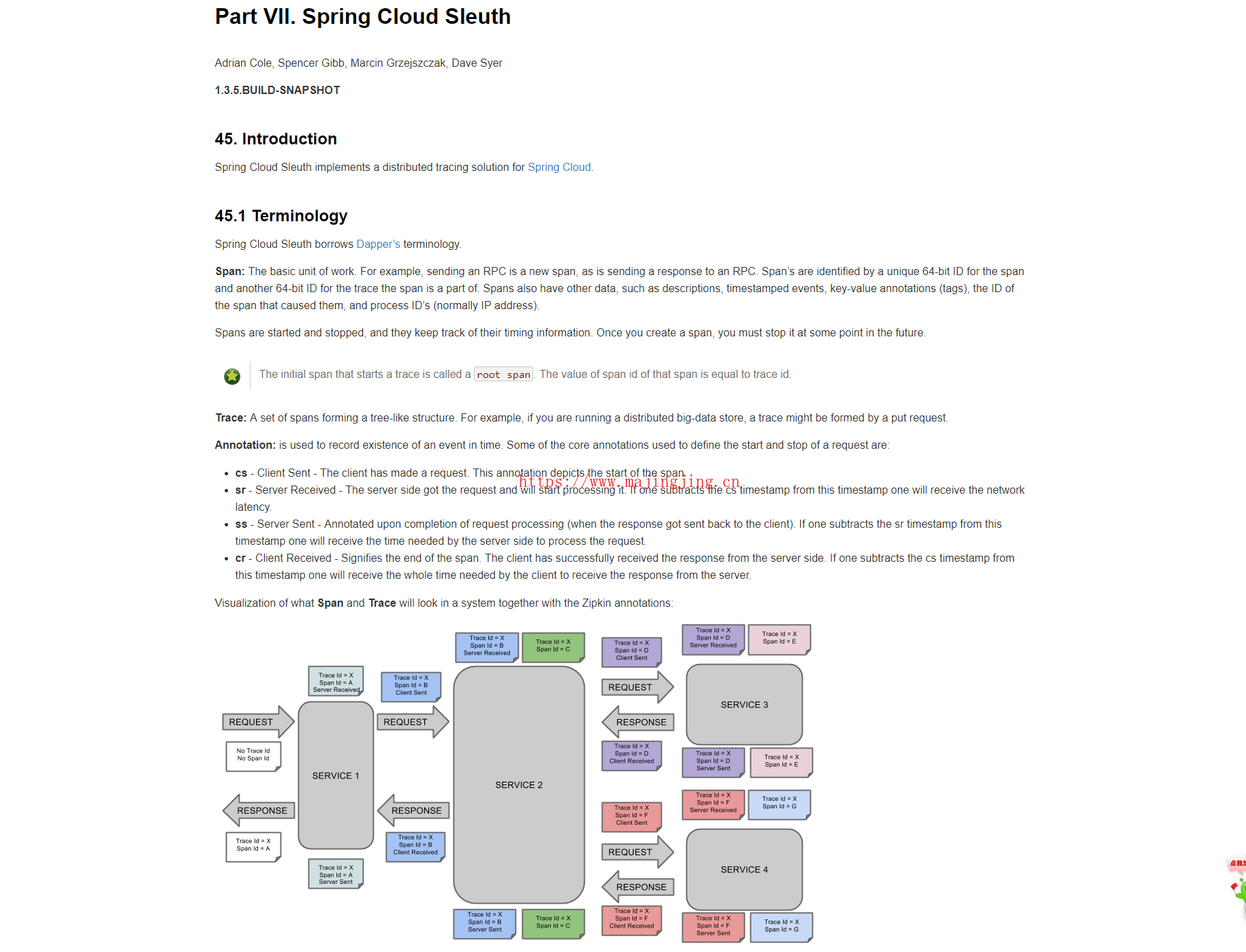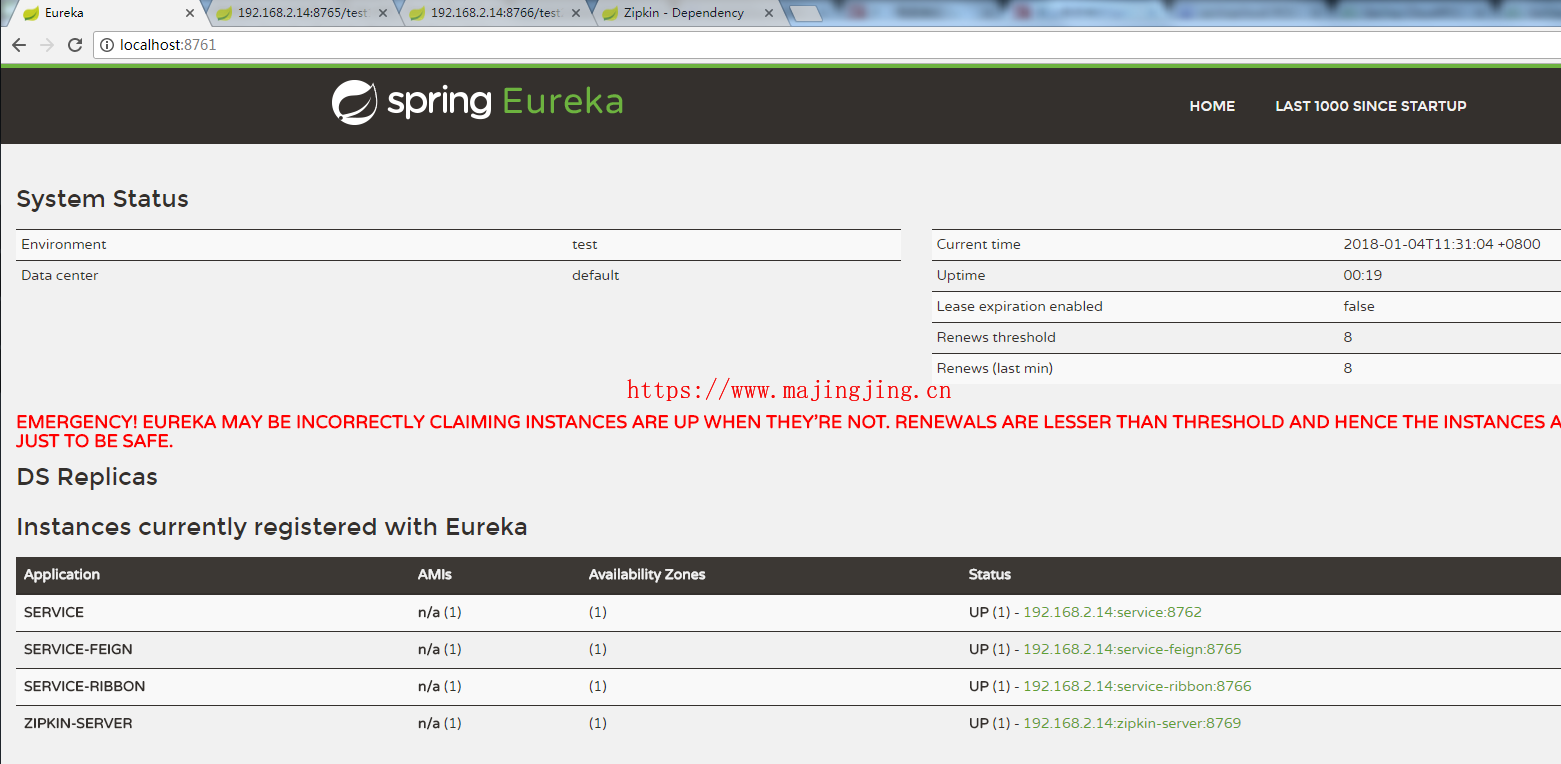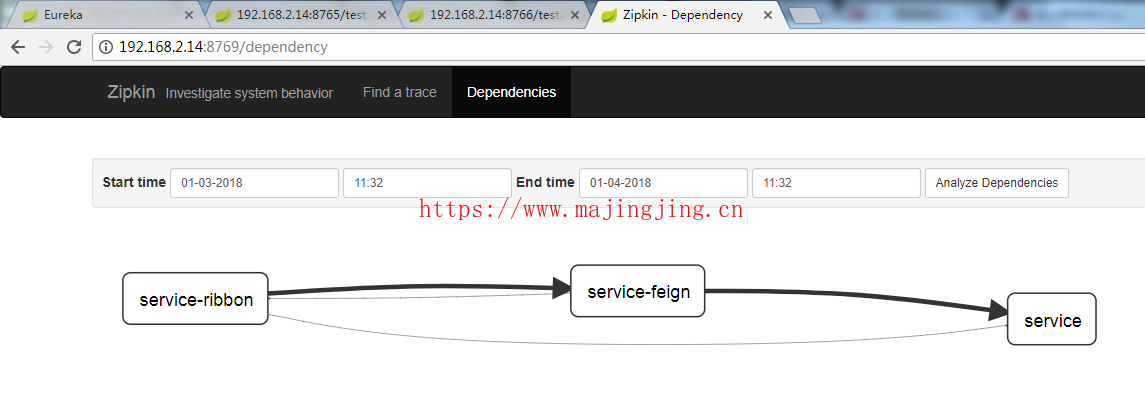Spring Cloud Sleuth为Spring Cloud实现分布式跟踪解决方案。

Zipkin是Twitter的一个开源项目,是一个致力于收集Twitter所有服务的监控数据的分布式跟踪系统,它提供了收集数据,和查询数据两大接口服务。
Spring Cloud Sleuth集成了zipkin组件
类似dubbo中的服务提供者和消费者一样,当我们的rest微服务很多的时候,服务之间的调用关系就会非常复杂,对调用链的分析会越来越复杂。

下面开始简单学习下sleuth和zipkin的集成使用
ZipkinServer搭建
1.构建一个maven项目 tm-zipkin-server (一个Zipkin服务器,您的应用程序 在端口9411上承载UI和API)
2.在pom中加入zipkin的依赖支持

<dependency>
<groupId>io.zipkin.java</groupId>
<artifactId>zipkin-server</artifactId>
</dependency>
<dependency>
<groupId>io.zipkin.java</groupId>
<artifactId>zipkin-autoconfigure-ui</artifactId>
</dependency>
3.在application.yml中增加配置参数
server:
port: 8769
spring:
application:
name: zipkin-server
eureka:
client:
serviceUrl:
defaultZone: http://localhost:8761/eureka/
4.在主启动类上增加注解 @EnableZipkinServer
@SpringBootApplication
@EnableDiscoveryClient
@EnableZipkinServer
public class ZipkinServerApplication {
public static void main(String[] args) {
SpringApplication.run(ZipkinServerApplication.class, args);
}
}
ZipkinClient搭建
现在我们来构建几个微服务的调用关系,比如有三个微服务(tm-service,tm-service-feign,tm-service-ribbon),调用关系如下
从tm-service-feign发送请求
/test1
feign ---> ribbon --> service
/test2
feign ---> service
从tm-service-ribbon发送请求
/test1
ribbon --> service
/test2
ribbon ---> feign --> service
tm-service搭建
1.构建maven项目 tm-service
2.在pom中增加zipkin依赖支持
<dependency>
<groupId>org.springframework.cloud</groupId>
<artifactId>spring-cloud-starter-zipkin</artifactId>
</dependency>
3.在application.yml中增加 zipkin 的配置
server:
port: 8762
spring:
application:
name: service
zipkin:
base-url: http://localhost:8769
eureka:
client:
serviceUrl:
defaultZone: http://localhost:8761/eureka/
4.对外提供3个服务
@RestController
public class ServiceController {
@Value("${server.port}")
String port;
@RequestMapping("/hello")
public String hello(@RequestParam(name = "name", defaultValue = "皇太极") String name) {
return String.format("service [hello]:%s , 欢迎使用[%s]的服务", name, port);
}
@RequestMapping("/test1")
public String test1(@RequestParam(name = "name", defaultValue = "皇太极") String name) {
return String.format("service [test1]:%s , 欢迎使用[%s]的服务", name, port);
}
@RequestMapping("/test2")
public String test2(@RequestParam(name = "name", defaultValue = "皇太极") String name) {
return String.format("service [test2]:%s , 欢迎使用[%s]的服务", name, port);
}
}
tm-service-feign搭建
1.构建maven项目 tm-service-feign
2.在pom文件中增加zipkin的依赖支持
<dependency>
<groupId>org.springframework.cloud</groupId>
<artifactId>spring-cloud-starter-zipkin</artifactId>
</dependency>
3.在application.yml中增加zipkin的配置
eureka:
client:
serviceUrl:
defaultZone: http://localhost:8761/eureka/
server:
port: 8765
spring:
application:
name: service-feign
zipkin:
base-url: http://localhost:8769
4.创建一个调用 tm-service 的客户端
@FeignClient(value = "service")
public interface IHelloService {
@RequestMapping(value = "/hello", method = RequestMethod.GET)
String hello(@RequestParam(value = "name") String name);
@RequestMapping("/test2")
String test2(@RequestParam(name = "name", defaultValue = "皇太极") String name);
}
5.创建一个调用 tm-ribbon 的客户端
@FeignClient(value = "service-ribbon")
public interface IRibbonService {
@RequestMapping("/test1")
String test1(@RequestParam(name = "name", defaultValue = "皇太极") String name);
}
6.对外提供3个服务接口
@RestController
public class HelloController {
@Autowired
IHelloService helloService;
@Autowired
IRibbonService ribbonService;
@RequestMapping(value = "/hello", method = RequestMethod.GET)
public String hello(@RequestParam(name = "name", defaultValue = "皇太极") String name) {
return "feign: " + helloService.hello(name);
}
@RequestMapping(value = "/test1", method = RequestMethod.GET)
public String test1(@RequestParam(name = "name", defaultValue = "皇太极") String name) {
return "feign ---> " + ribbonService.test1(name);
}
@RequestMapping(value = "/test2", method = RequestMethod.GET)
public String test2(@RequestParam(name = "name", defaultValue = "皇太极") String name) {
return "feign ---> " + helloService.test2(name);
}
}
tm-service-ribbon构建
1.构建maven项目 tm-service-ribbon
2.在pom中引入 zipkin 依赖支持
<dependency>
<groupId>org.springframework.cloud</groupId>
<artifactId>spring-cloud-starter-zipkin</artifactId>
</dependency>
3.在application.yml中增加zipkin的配置
eureka:
client:
serviceUrl:
defaultZone: http://localhost:8761/eureka/
server:
port: 8766
spring:
application:
name: service-ribbon
zipkin:
base-url: http://localhost:8769
4.对外提供3个服务接口,分别调用到 tm-service , tm-service-feign 服务
@RestController
public class HelloController {
@Autowired
RestTemplate restTemplate;
@RequestMapping(value = "/hello", method = RequestMethod.GET)
public String hello(@RequestParam(name = "name", defaultValue = "皇太极") String name) {
return "ribbon ---> " + restTemplate.getForObject("http://SERVICE/hello?name=" + name, String.class);
}
@RequestMapping("/test1")
public String test1(@RequestParam(name = "name", defaultValue = "皇太极") String name) {
return "ribbon ---> " + restTemplate.getForObject("http://SERVICE/test1?name=" + name, String.class);
}
@RequestMapping("/test2")
public String test2(@RequestParam(name = "name", defaultValue = "皇太极") String name) {
return "ribbon ---> " + restTemplate.getForObject("http://SERVICE-FEIGN/test2?name=" + name, String.class);
}
}
环境搭建完成,下面来看下实际效果。
演示效果
1.分别启动项目(tm-eureka-server,tm-service,tm-service-feign,tm-service-ribbon,tm-zipkin-server)
2.浏览器访问 http://localhost:8761/

http://192.168.2.14:8765/test1

http://192.168.2.14:8765/test2

http://192.168.2.14:8766/test1

http://192.168.2.14:8766/test2

http://192.168.2.14:8769/



通过zipkin的控制台页面我们可以非常方便的看到每个微服务的调用依赖关系,和请求调用的消耗时间,以及调用参数等其他相关的信息。使得微服务的调用链关系非常清晰。
 打赏下吧
打赏下吧

